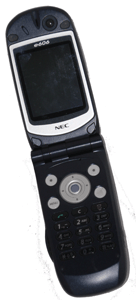First 3G phones

On 3/3/2003 Hutchinson Telecom, the company originally behind Orange, announced the UK's first commercial third generation or 3G mobile phone network. The new network was called 3.
3G offered greater data bandwidth, proper web browsing, email and the ability to send video as well as pictures over the mobile phone network. For the first time you could see a moving picture of the person who was calling. It was a big step forward from the camera phones which first came to the UK only a year earlier.
Japan was first country to have a 3G network. NTT DoCoMo launched the world's first commercial 3G network in Japan on 1 October 2001, before we in the UK could even send pictures by phone. Shoppers packed mobile phones stores in Japan to catch a glimpse of the new technology.
On 3 March 2003, Trade and Industry Secretary, Patricia Hewitt, made the first video call on the UK 3 network to Stephen Timms, Minister for e-Commerce. Hutchinson was not quite ready for everyone to get their hands on the first handsets, which could be pre-ordered, but did not arrive until later in the month.
Hutchinson did not technically have the honour the being the first UK 3G provider as Manx Telecom had been operating a 3G service on the Isle of Man since 1 December 2001. However, it was a limited non-commercial service.
3G came with a high price tag. In April 2000 the UK economy had a £22 billion windfall when Chancellor Gordon Brown auctioned the licences to operate a 3G service in the UK. Hutchinson took one of the licences and the others went to the four established mobile phone operators: Vodafone, BT, Orange and One2One.
After the auction it took several years for the operators to make 3G work. With such a high price to pay for the licences and years of research and development to recover, it was not surprising that they wanted a high return from the phones. 3 offered a choice of three handsets. All three were offered at a 50% discount on the RRP, provided you signed up by the end of March 2003. The three handsets and discounted launch prices were:
- Motorola A830 - £125
- NEC e606 - £200
- NEC e808 - £225
Once you had paid for the handset using the phone would cost a further £59.99 per month. Unlike camera phones, which commentators had feared would be too expensive, but proved a success, the public was slow to take to 3G.
This, together with technical difficulties, meant other operators were slow to launch their consumer 3G networks. The big four initially concentrated on the business market. Vodafone was the first with a consumer 3G network which stared in late 2004.
If further bad news was needed, a Which? report in December 2004 concluded that 3G was poor value for money. At that time the networks did not cover the whole of the UK. 3 still only covered 80% and Vodafone 60%. The new handsets were bulkier than the old 2G phones, which by 2004 were very slim and light. 3G did not make 2G obsolete; even in 2007 the first iPhone was launched on 2G.
Nevertheless, 3G eventually became the network of the current generation of smart phones.
Resources
Explore 3's website www.three.co.uk in February 2003, just before the launch date.
Article by Steven Braggs, January 2013
Comments (2)
I had a Motorola A835 on 3 it was so bulky and heavy. It was not a candy bar, but had buttons. The screen covering less than 1/2 the front. Getting a 3g signal was no picnic as leaving town was the only option. The phone was free to all members of Superdrug. The store manager would get the preferable A830. Which I believe had a touch screen.